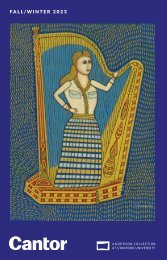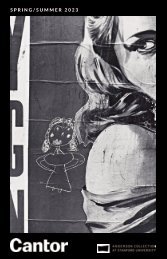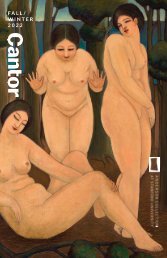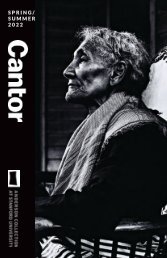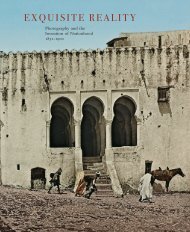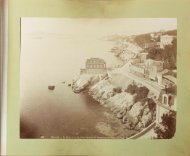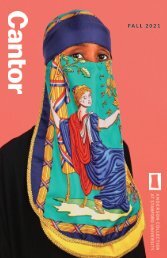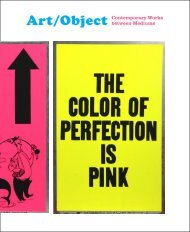Cantor Family Guide 1
Learn new and fun facts about the art displayed at the Cantor with this family guide. For more activities, visit us at museum.stanford.edu/programs/family-programs
Learn new and fun facts about the art displayed at the Cantor with this family guide. For more activities, visit us at museum.stanford.edu/programs/family-programs
You also want an ePaper? Increase the reach of your titles
YUMPU automatically turns print PDFs into web optimized ePapers that Google loves.
<strong>Family</strong> <strong>Guide</strong>
1<br />
Meet<br />
Viktoria!<br />
This life size sculpture was made by artist Deborah<br />
Butterfield. She loves horses and uses found and<br />
natural materials to make her artwork.<br />
Did you KNOW?<br />
Viktoria looks like it’s<br />
made of wood, but it’s<br />
actually not!<br />
What is Viktoria made of?<br />
WOOD STONE BRONZE
Second Floor<br />
LEGEND<br />
WHOOO ARE YOU?<br />
Not sure where to go? Follow<br />
the YELLOW ROAD through the<br />
museum. Come and find me!<br />
marks the spot!<br />
TEMPORARY EXHIBITION<br />
SCULPTURE<br />
TERRACE<br />
STAIRS<br />
ELEVATOR<br />
CONTEMPORARY<br />
ART<br />
TEMPORARY<br />
EXHIBITION<br />
TEMPORARY<br />
EXHIBITION<br />
INDIGENOUS<br />
AMERICAN ART<br />
STAIRS<br />
ELEVATOR<br />
EUROPEAN<br />
& AMERICAN ART<br />
NEW ACQUISITIONS<br />
EARLY EUROPEAN<br />
ART<br />
INDIGENOUS<br />
AMERICAN<br />
ART<br />
First Floor<br />
CONTEMPORARY ART<br />
AUDITORIUM<br />
STAIRS<br />
ELEVATOR<br />
i<br />
RODIN<br />
COURTYARD<br />
STANFORD<br />
FAMILY<br />
GALLERY<br />
ELEVATOR<br />
ASIAN<br />
ART<br />
STAIRS<br />
B. GERALD CANTOR<br />
RODIN SCULPTURE<br />
GARDEN<br />
RODIN<br />
LOCKERS<br />
OCEANIC ART<br />
RODIN<br />
AFRICAN ART<br />
LIFT<br />
STAIRS<br />
MAIN LOBBY<br />
i<br />
STAIRS<br />
ASIAN ART<br />
ASIAN ART<br />
YO
3<br />
Featured<br />
artworks<br />
Incense Burner in the Form of a<br />
Fantastic Beast (qilin)<br />
Artist unknown (China), 17th century-18th century.<br />
Cloisonné enamels. Stanford <strong>Family</strong> Collections, JLS.9157<br />
The qilin is a divine and peaceful mythical creature that<br />
is quiet by nature and has magical powers. It is said that<br />
its voices sound like the tinkling of bells, chimes, and the<br />
wind. The qilin has a Chinese dragon-like head with the<br />
antlers of a deer and carp fish whiskers. Look! The body<br />
is shaped like an ox, deer or horse.<br />
ASIAN ART GALLERY<br />
Owl<br />
Lucy Lewis (American, c. 1900-1992), 1966. Earthenware.<br />
Gift of Eleanor Swent, 2014.36<br />
Lucy Lewis was a Native American potter from Acoma<br />
Pueblo, New Mexico. She was known for her decorative<br />
pottery made using traditional techniques. She sometimes<br />
made pots in the shape of animals, like turkeys or owls.<br />
INDIGENOUS AMERICAN ART GALLERY<br />
Polychrome Male Figure<br />
Artist unknown (Cochiti Pueblo, New Mexico, USA), c.<br />
1892. Ceramic. Stanford <strong>Family</strong> Collections, JLS.8744<br />
Traditional Cochiti pottery is often cream-colored<br />
with designs of rain, clouds, animals, and flowers<br />
painted in black. More recently, potters developed<br />
the story-teller figure, like the one at the <strong>Cantor</strong>,<br />
as well as storyteller animals.<br />
INDIGENOUS AMERICAN ART GALLERY<br />
Viktoria (Pictured, opposite panel)<br />
Deborah Butterfield (American, born 1949), 1999. Bronze. Gift of Burton<br />
and Deedee McMurtry, 2008.46<br />
This larger-than-life sculpture was created by fastening pieces of driftwood together.<br />
The artist then moved the driftwood horse to a foundry where workers made a casting<br />
in bronze to replace the wood. A patina was applied to add color to the bronze and<br />
make it look exactly like real driftwood. Butterfield named the sculpture Viktoria.<br />
MAIN LOBBY
Museum Manners<br />
Please look at the art with your eyes<br />
but do not touch. Staying at least an arm’s<br />
length away is a good way to remember.<br />
If you get lost or have any questions<br />
about the art museum there are friendly<br />
guards stationed throughout the galleries.<br />
Say hello, and don’t be afraid to ask them<br />
for help if you need it.<br />
Children must stay close to their parents<br />
or an adult supervisor at all times.<br />
Remember to walk, not run, in the<br />
museum. Always be aware of your<br />
surroundings (art may be behind you).<br />
The Rodin Sculpture Garden is part of<br />
the museum so we use our museum<br />
manners there even though we are<br />
outside. We can protect the art by not<br />
climbing on the sculpture pedestals and<br />
not playing with the gravel.<br />
<br />
Museum manners<br />
are rules that help keep<br />
the art (like me) safe,<br />
and help you to have<br />
a great experience at<br />
the museum!
museum.stanford.edu | @cantorarts<br />
328 Lomita Drive at Museum Way, Stanford, CA 94305-5060<br />
Support for <strong>Family</strong> <strong>Guide</strong>s is provided by the Koret Foundation.<br />
THIS GUIDE WAS MADE USING RECYCLED PAPER PLEASE HELP SAVE OUR PLANET BY<br />
RECYCLING IT. OR... TAKE IT HOME AND USE IT TO MAKE YOUR OWN ARTWORK!<br />
THANK YOU






